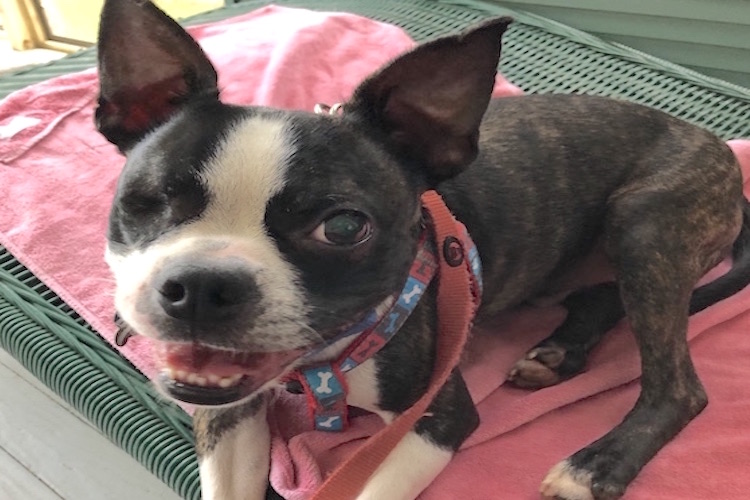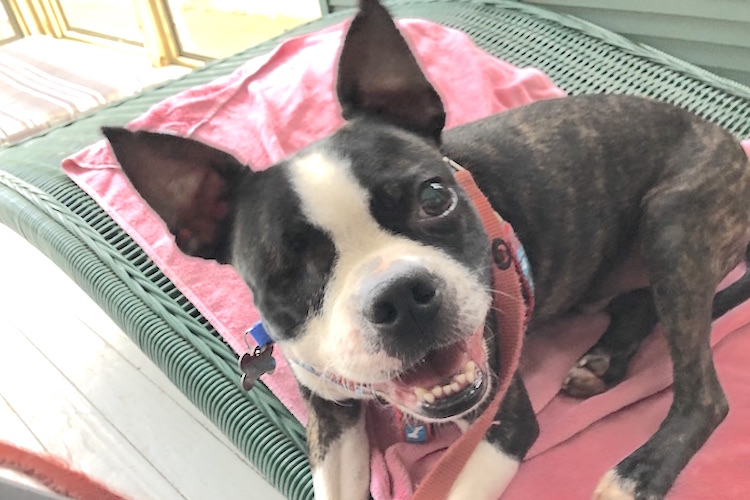In a different blog post, I shared that I took a (long) break from fostering to focus on some personal projects. I’m still sorta in the thick of things, but …. this little fella needs help and I decided to try and give him the help he needs. We shall see! He does not like dogs, per report, and you all know Otis isn’t the most well-mannered around stranger dogs. I may ask you all for some ideas! Many of you know how it feels to bring home a new foster dog! The unknowns certainly produce anxiety for me! Do you get nervous bringing home a new dog?
Carter's Story
Employees for a veterinary clinic in Mississippi arrived to work one morning, early January. The outside temperature dropped into the 20’s overnight. At the back of the property stood a cow barn, and staff discovered this little skinny dog burrowed in the middle of a pile of hay up against the building. If not for that hay, he would have frozen to death.
Someone abandoned him on the property sometime after closing the day before.
Hurriedly, staff brought him inside. He was injured; his right eye sustained trauma some time ago, and clearly it was beyond repair. Oh, the pain he must have been in! The vet evaluated his overall health, and, while a young dog (4 years old or so) and in overall good health, he tested positive for heartworm. He also had hookworms, and yes – he was intact.
Treating The Hurt
The veterinarian removed his eye, neutered him, and provided treatment for his hookworms. While Carter recovered, rescue volunteers sent out a plea for a foster home where Carter could complete heartworm treatment. After delaying this treatment long enough and with no foster home available or agreeable to take him, Carter began and completed his heartworm treatment while in boarding at the vet clinic. The staff at the clinic adore him and give him as much attention as they can, but at the end of the day, he’s been without a foster home for a long time.
To date, no one seems interested in adopting him, either.
Living in a foster home will likely improve Carter’s behavior, or will for sure give some clarity to Carter’s issues with other dogs – which will improve his odds for adoption, don’t you agree? Keep reading – I get to meet Carter!
I Meet Carter!

Carter is much less of a “wild man” on a leash than I expected, very affectionate – a little demanding about it but knows that a “sit” will get my attention a little bit faster. I heard he was a mix, but to me, he’s clearly a little Bo-Jack. (Boston/Jack Russell Terrier.) He put on a few “el-bees” while in boarding, but he’ll get trimmed up in due time.
Every New Foster Dog Gets A "Rehab" Plan
I’ve yet to welcome a foster dog into my home that wouldn’t benefit from a targeted medical or behavioral goal, and Carter is no different. Our first week together will help me sort out what is most important for Carter, and allowing Carter to be who he his (within the rules of the house) will help him decompress a bit quicker, allowing me to see how best to help him learn.
Safety, First!
With Otis in the house, my number one goal will be safety for everyone. I usually set up ALL of my baby gates, creating a kind of locks and dams environment so that I can move dogs about without them having to pass each other in the same room. I also use baby gates for introductions, although something in my gut is telling me Carter may be a baby gate jumper, so I’m mulling over my plan B should baby gates not contain him! Eeek!
My other safety goals are to determine:
Is he a door darter or escape artist?
Is he a pro at slipping his collar or harness?
Has he ever been taught recall?
Does he ingest things he shouldn’t?
Simply put, I don’t want to lose this dog or have him become injured, nor do I want to find myself taking him in to remove a gut obstruction.
Build A Relationship
I say it all the time, if you are not working toward building a relationship with your foster dog, you are not fostering. You are housing. It’s the same difference as you attending a retreat or vacationing at a resort. Both have benefits. Both have entirely different outcomes.
Look, I’m all for showing love to an animal that has experienced a hard life. Kindness is good, no one is going to argue that point. However, If I have an opportunity to provide a dog the opportunity to acquire a necessary skill that will improve their connection to humans, possibly their connection to other animals, and help them redefine the world in which they live, I’m going to do that.
What will building a relationship look like as Carter and I navigate our first week together?
Observe and Observe Some More
There’s a lot to learn about this little fella. I need to learn pretty quickly if he’s house trained and crate trained. I need to learn his eating and eliminating habits. For his safety, I need to get him pretty comfortable being on leash, so I need to recognize early signs of frustration when tethered. How excitable or frustrated does he become, and what does he do when he’s in this state of mind?
Other ways I’ll “listen”:
- Are there places on his body where he doesn’t like to be touched? Does he have a favorite spot? Is he a snuggler? Does he like his own space?
- What makes him feel safe? A pile of blankets? A quiet corner? A tented crate? A particular toy?
- Does he have any fears? Of noise? Storms? Separation? Movement?
- Does he sleep through the night? If not, why?
- Does he have any evidence of pain? Like a knee issue or spinal issue?
- Does he have any training at all? Does he respond to basic manners cues?
- What motivates him? Is he food motivated? Toy motivated? Does he have any play skills at all?
Here Are The Rules, Buddy
While I mostly will listen and observe, I’ve drafted some rules of the house for new guests:
- we don’t mark anything inside. We also don’t mark the exterior of the house!
- I will take you outside at frequent intervals in order for you to eliminate outside. In turn, you need to eliminate outside.
- I will give you plenty of choices. But if you want (food, treat, attention, movement) you have to show me some control. We are already practicing sit AND WAIT for doors to completely open and for me to give a release cue as he’s a known door darter.
Check in frequently! We will be talking about Carter’s first few days with me in a foster home and what unfolds. This little nugget has a lot to tell me.
I already know: This is a good dog.





Gosh, Carter has really been through a lot. Bad enough that someone abandoned him in the cold but they also abandoned him injured! I look forward to reading future updates. I am sure he will make wonderful progress in your home.
Our dog Ruby doesn’t do well with other dogs and had a rough time in her early life so we don’t push it. She does very well with cats so for now we are sticking with fostering cats.
It’s a real dance fostering a dog with social challenges when your own dog has them, too. Somehow, my Otis has gotten a little more relaxed over the years because I choose to carefully foster, but not enough better that I can adopt another dog, which is sad, but OK, too.
I’m glad Ruby feels safe with cats and can have a furry companion! They are both beautiful.